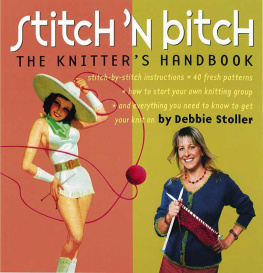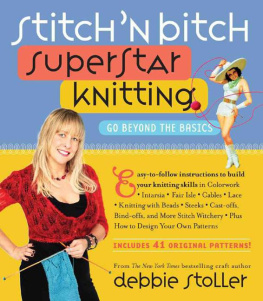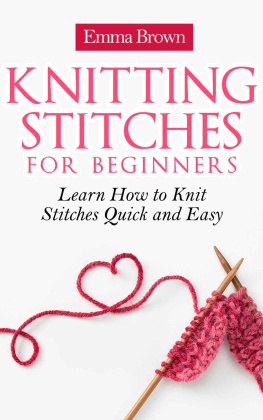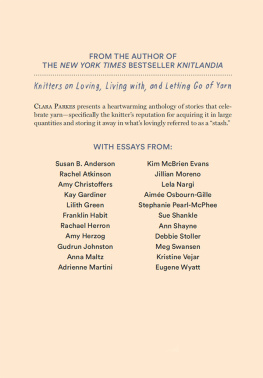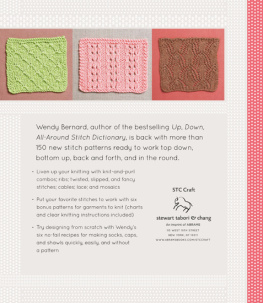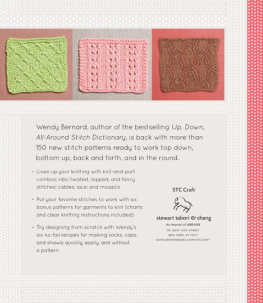Stitch n Bitch
THE KNITTERS HANDBOOK

by Debbie Stoller
Illustrations by Adrienne Yan
Fashion photography by John Dolan
WORKMAN PUBLISHING NEW YORK
Dedicated to Johanna Cornelia Borsje-Gorissen
May 26, 1899 March 20, 2003

Acknowledgments
Lots of people helped to make this book come together. At Workman, I thank Jessica Firger for approaching me with the idea in the first place and getting this knitting party started. I am deeply indebted to Ruth Sullivan, whose careful and patient editing greatly improved the copy and helped to make my words make sense. Im particularly amazed that shea nonknitterwas able to get through the many rereadings of the technical portions of the text, even though they made her eyes glaze over. Thanks to Janet Vicario for creating the exceptionally cute n sassy design, and for holding my hand through the cover shoot, and to Leora Kahn, for putting together a photo shoot that made the projects look so cool. Rebecca Schiff has been a great help, especially in pulling together a resources section when other demands kept me from being able to do so myself. Thank you to Betty Christiansen, a fine knitter and possibly even finer copyeditor. Finally, Im very grateful to Eve Ng, who served as technical editor on the patterns in this bookif it werent for her attention to the knitty-gritty details, some of these scarves might have turned out to be sweaters, and vice versa.
I wish to thank the many designers who contributed their patterns and their timethey deserve such a huge part of the credit for making this book what it isas well as the helping hands who volunteered to knit some of the projects included here: Molly Steenson (Skully), Anna McElheny (red Pippi Kneestockings), Galit Ben-Baruch (blue Pippi Kneestockings), Marney Anderson (bunny Punk Rock Backpack), Tracie Egan (Ribbed-for-Her-Pleasure Scarf), and my late-night, last-minute knitting crew: Meema Spadola, Jackie Broner, Stephanie Sterner, Barbara Pizio, and Sonya Laska.
Melanie Falick is one of my knitting in pirations and was gracious enough to share her invaluable advice with me on this book, and Im also thankful that Mark Mann agreed to take a break from his usual celebrity work to take some pictures of me for the cover.
I want to thank Johanna and Bernard Stoller, and especially Michael Uman, for supporting me throughout the emotional process of writing a book and trying to meet seemingly impossible deadlines, and Im particularly grateful to my awesome business partner, Laurie Henzel, and the rest of the staff of BUST magazine for allowing me the time I needed to get this cat in the bag.
Finally, I want to give a special shout out to everyone whos attended New York City Stitch n Bitch sessions over the past four years; you all have kept knitting fun and alive for me.
Contents
Take Back the Knit
Why Young Women Are Taking Up Knitting Once More
What a Girl Wants, What a Girl Needs
Tools of the Trade
The Knitty-Gritty
Learning to Cast On, Bind Off, and Knit
Purl, Too
Learning to Purl and Make Simple Stitch Patterns
Shaping Up
Learning to Increase and Decrease
Finishing School
Learning to Sew Seams, Pick Up Stitches, and Block Your Work
Getting Knitty with It
Fancy Things to Do with Needles and Yarn
Oops, I Knit It Again
The Stitch Doctors Guide to Fixing Mistakes
A Loosely Knit Group
A Guide to the Wonderful World of Knitters



Stitch n Bitch
part one
Take Back the Knit
WHY YOUNG WOMEN ARE TAKING UP KNITTING ONCE MORE
My Crafty Family
My grandmother sits, straight-backed, in the living-room chair, her feet planted firmly on the floor in front of her. As always, her hands are in motionconstantly in motionas her knitting needles go back and forth, yarn feeding through her hands from a ball that unwinds slowly at her side. My grandmothers hands are old and so smooth they seem to have had the fingerprints worn off them. Her sister, my great-aunt Jo, sits beside her, tatting lace onto the edge of a handkerchief. My mother and Aunt Hetty work on their own embroidery projects, and, along with the other aunts and uncles who are visiting, all of the adults are engaged in a lively conversation, punctuated by rounds of hearty laughter. Too young to join in the grown-ups discussion, I sit on a small stool, quietly eating cake. After all, this is a birthday party.
My mother met my dad and moved to America when she was twenty-four, but for most of my childhood we spent our summers back in Holland with her relatives. Between my grandmother and her eight sisters, and my mom and her two sisters, there were always aunts and great-aunts around. Women filled every room. And whenever the relatives were gathered together, the womens hands were always working. With very few exceptions, and with barely any attention paid to what was going on below their elbows, the women would be busy knitting or sewing, darning or tatting. It didnt so much matter what they were makingafter all, what purpose is served by hand-tatted lace sewn on the edge of a handkerchief?as long as their hands remained in motion, for, as my grandmother used to say, Idle hands are the devils workshop.

But there was something else behind all this activity as well. The handwork of my grandmother and great-aunts seemed to provide comfort and serenity. Seated at these family gatherings, their purposeful motions gave them a focused air of self-containment, an earthy solidity. They were, after all, women who had learned their crafts as children, and who had practiced these skills throughout their livesbefore and after the birth of children, the loss of husbands, and through two world wars. Their knitting was as regular and rhythmic as their breathing, as familiar as the feel of their own skin, and just as much a part of them.

My grandmother and her sisters were too humble to consider their work expressions of their creativity. They were craftspeople, plain and simple, who were capable of taking on the most complex of knitting projects but who, for the most part, were content to keep themselves working on functional items whose patterns they knew by heart. From the time she first learned to knit, at age six, my grandmother was responsible for knitting socks to cover each of the thirty feet in her family. In the evenings, the boys were free to do anything they liked, she once told me, with a lingering tinge of resentment, but all the girls had to sit and knit. Later on in her life she made more extravagant items, including a fanciful knit suit in a beautiful, dusty-rose-colored nubby yarn, which my aunt still talks about to this day. But my grandmother always returned to her sock knitting. Even in her nineties, when her eyesight began to fail, she could still turn out perfect pairs of socksthe memory of their creation so well worn into her hands that she could knit them practically by feel alone. My grandmothers hand-knit socks are still the only thing my father ever wears on his feet.

